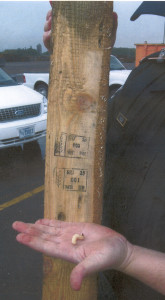As we Americans import more stuff, the risk of new pest introductions rises, too. Many tree-killing insects arrive as larvae living in crates, pallets, and other forms of wood packaging. While the USDA requires that incoming wood packaging be treated to prevent pests, this regulation has not prevented pests from entering the country on wood packaging.

A study has found that perhaps 35 shipping containers harboring tree-killing pests reach our ports each day (Haack et al. 2014). At this rate, in just 35 years, America might suffer invasion by more than 100 new wood-boring species. This would result in a tripling of borers introduced to U.S. (Leung et al. 2014).
Already, wood-boring beetles have been among the most damaging tree-killing pests introduced to the U.S. Our environment certainly doesn’t need invasions by three times as many new wood-borers!
West-coast ports receive lots of incoming shipping containers. Long Beach alone receives about half of the nearly 25 million shipping containers arriving at the U.S. each year. So it is alarming that high-risk insects, including the Asian longhorned beetle (ALB), continue to be found in wood packaging (Berger 2014).
Imported goods that are heavy are more likely to be packaged in wood and that thus pose the greatest pest risk. The highest risk commodities are
• machinery (including electronics) and metals;
• tile and decorative stone (such as marble or granite counter tops) (Harriger 2014).
The west coast ports of Seattle, Los Angeles/Long Beach, and San Francisco all rank in the top 15 out of 3,500 (1/2 of 1%) cities nation-wide for imports of tile and decorative stone, machinery and metals (Colunga-Garcia et al. 2009).
Not only do west coast cities import high volumes of risky goods; a significant proportion of the trees growing in those cities are vulnerable to these pests. Seattle’s three to four million trees belong to more than 300 species – although a mere seven genera constitute two-thirds of the trees (Ciecko et al. 2012). It has been estimated that just four non-native pests (ALB, gypsy moth, emerald ash borer, and “Dutch” elm disease) could cause $3.5 billion in damages. The ALB alone threatens 39.5% of all trees lining the city’s streets (City of Seattle 2013).
San Francisco has an estimated 669,000 trees; 12% are at risk to the ALB (Nowak et al. 2007). Apparently no one has yet estimated the numbers of trees at risk to sudden oak death (SOD), goldspotted oak borer (GSOB), or polypagous shot hole borer (PSHB).
It is essential that USDA APHIS act more aggressively to prevent additional introductions of pests via wood packaging. (For a longer discussion of the wood packaging pathway, visit my previous blog posted on July 15th). In brief:
• APHIS & the Bureau of Customs and Border protection should penalize all importers whose wood packaging does not comply with decade-old regulatory requirements.
• The Bureau of Customs and Border Protection should incorporate the wood packaging requirements into its “Customs-Trade Partnership Against Terrorism” (C-TPAT) program
• APHIS should re-consider the advantages of requiring importers to switch to packaging made from materials other than wooden boards.
• The President’s Office of Management and Budget should allow APHIS to finalize regulations – proposed in 5 years ago! – that would apply the international standard’s treatment requirements to wood packaging used in trade between the US and Canada. (Canada has been ready to adopt this measure for several years.)
SOURCES
Berger, P. Executive Director, PPQ Science and Technology, Presentation to the Continental Dialogue on Non-Native Forest Insects and Diseases, November 3, 2014
Ciecko, L., K. Tenneson, J. Dilley, K. Wolf. 2012. Seattle’s Forest Ecosystem Values: Analysis of the Structure, Function, and Economic Benefits; August 2012; GREEN CITIES RESEARCH ALLIANCE; City of Seattle Urban Forest Stewardship Plan 2013.
City of Seattle Urban Forest Stewardship Plan 2013.
Colunga-Garcia, M., R.A. Haack, and A.O. Adelaja. 2009. Freight Transportation and the Potential for Invasions of Exotic Insects in Urban and Periurban Forests of the US. J. Econ. Entomol. 102(1): 237-246 (2009); and raw data for the study provided by the authors.
Haack, R.A., F. Herard, J. Sun, J.J. Burgeon. 2009. Managing Invasive Populations of Asian Longhorned Beetle and Citrus Longhorned Beetle: A Worldwide Perspective. Annu. Rev. Entomol. 2010. 55:521-46.
Haack RA, Britton KO, Brockerhoff EG, Cavey JF, Garrett LJ, et al. (2014) Effectiveness of the International Phytosanitary Standard ISPM No. 15 on Reducing Wood Borer Infestation Rates in Wood Packaging Material Entering the United States. PLoS ONE 9(5): e96611. doi:10.1371/journal.pone.0096611
Harriger, K. 2014. Presentation to the Continental Dialogue on Non-Native Forest Insects and Diseases, November 3, 2014
Leung, B., M.R. Springborn, J.A. Turner, E.G. Brockerhoff. 2014. Pathway-level risk analysis: the net present value of an invasive species policy in the US. The Ecological Society of America. Frontiers of Ecology.org
Nowak, D.J., R.E. Hoehn III, D.E. Crane, J.C. Stevens, J. T. Walton. 2007. Assessing Urban Forest Effects and Values: San Francisco’s Urban Forest. USDA Forest Service. Northern Research Station. Resource Bulletin NRS-8.
posted by F.T. Campbell
Thanks for sharing this crucial information. You would think that our government would be protecting us from this — but no. I will be on the lookout here in Ventura County, California for these types of pests.